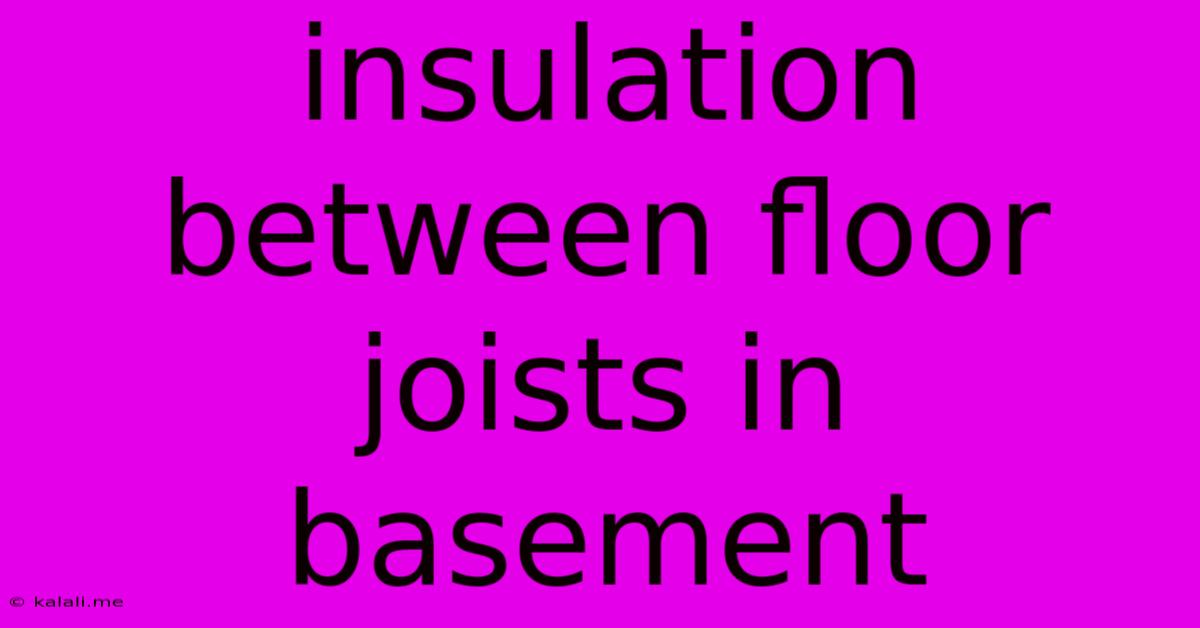Insulation Between Floor Joists In Basement
Kalali
May 25, 2025 · 3 min read

Table of Contents
Insulating Between Floor Joists in Your Basement: A Comprehensive Guide
Meta Description: Learn how to properly insulate between floor joists in your basement to improve energy efficiency, reduce noise, and increase comfort. This guide covers materials, techniques, and best practices.
Improving your home's energy efficiency often starts with tackling areas of significant heat loss. For many homes, the basement presents a prime opportunity for significant improvements. Insulating between floor joists in your basement is a highly effective way to reduce energy costs, minimize noise transfer from the basement, and create a more comfortable living space above. This comprehensive guide will walk you through the process, covering the best materials, techniques, and important considerations.
Choosing the Right Insulation Material
Selecting the appropriate insulation material is crucial for optimal performance and longevity. Several excellent options exist, each with its own pros and cons:
-
Fiberglass Batt Insulation: This is a popular and cost-effective choice. Fiberglass batts are readily available, easy to install, and provide good thermal resistance. Remember to wear appropriate protective gear, such as gloves and a mask, during installation.
-
Mineral Wool Insulation (Rockwool or Glasswool): Offering superior sound dampening capabilities compared to fiberglass, mineral wool is a more sustainable and environmentally friendly option. It also performs well in humid environments. However, it can be slightly more expensive.
-
Rigid Foam Board Insulation (Polyisocyanurate or Extruded Polystyrene): Known for its high R-value (a measure of thermal resistance), rigid foam board provides excellent insulation and acts as a vapor barrier. While more expensive, it's ideal for areas prone to moisture problems. Properly sealing the seams is essential.
-
Loose-Fill Cellulose Insulation: A sustainable option made from recycled paper, loose-fill cellulose can be blown into place, filling all gaps and crevices effectively. It offers good thermal performance and sound absorption.
The best choice depends on your budget, environmental concerns, and the specific needs of your basement. Consider factors like moisture levels, existing vapor barriers, and sound control requirements when making your decision.
Step-by-Step Installation Guide
Once you've selected your insulation material, follow these steps for a successful installation:
-
Preparation is Key: Before beginning, clear the area under the floor joists. Ensure the joist space is clean and free of debris. Wear appropriate safety gear.
-
Vapor Barrier (If Needed): If you're installing insulation in a climate prone to high humidity, consider installing a vapor barrier. This prevents moisture from penetrating the insulation and causing damage. Polyurethane sheeting is a common choice. Ensure any seams are properly sealed with appropriate tape.
-
Insulation Placement: Carefully fit the chosen insulation material between the floor joists, ensuring a snug fit. For batt insulation, cut to length as needed to avoid compression. For loose-fill insulation, use a specialized blower to evenly distribute the material.
-
Addressing Obstacles: Pipes, wires, and other obstructions may require you to cut the insulation to accommodate them. Seal any gaps around these obstructions with caulk or expanding foam sealant to maintain insulation integrity.
-
Finishing Touches: Once the insulation is in place, consider adding a layer of plywood or other suitable material over the joists to create a level surface for flooring if needed. This also contributes to better soundproofing.
Important Considerations
-
R-Value: The R-value of your insulation directly affects its effectiveness. Consult local building codes and climate conditions to determine the appropriate R-value for your area. Higher R-values mean better insulation.
-
Moisture Control: Basement insulation is particularly susceptible to moisture issues. Proper ventilation and moisture control are crucial for preventing mold and mildew growth.
-
Fire Safety: Always choose fire-resistant insulation materials and follow all fire safety regulations during installation.
By following these steps and considering the factors mentioned above, you can effectively insulate between your basement floor joists, improving energy efficiency, reducing noise, and creating a more comfortable home. Remember to consult local building codes and consider seeking professional help if you are unsure about any aspect of the process.
Latest Posts
Latest Posts
-
Egyptian Book Of The Dead Ten Commandments
May 25, 2025
-
Project A Point Onto A Line
May 25, 2025
-
How To Find Range Of A Matrix
May 25, 2025
-
Why Does Frodo Have To Leave
May 25, 2025
-
How To Send An Email As An Attachment On Iphone
May 25, 2025
Related Post
Thank you for visiting our website which covers about Insulation Between Floor Joists In Basement . We hope the information provided has been useful to you. Feel free to contact us if you have any questions or need further assistance. See you next time and don't miss to bookmark.